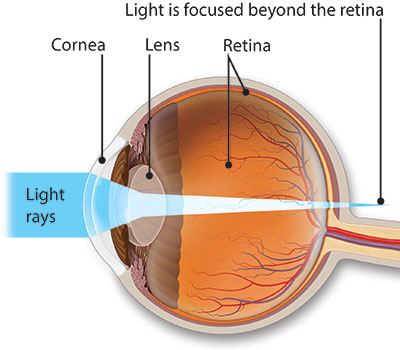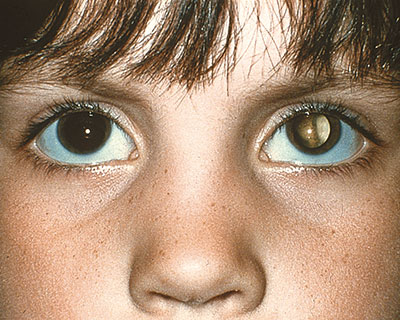Vision Screening Detects Eye Diseases in Kids
While many eye problems happen in adulthood, a child’s vision—without screening by your doctor or eye care professional— is also vulnerable to eye disease. By finding and treating problems early, healthy vision can develop. Learn about childhood eye conditions and screen your child regularly to protect their vision.
Left Untreated, Poor Eyesight Can Lead to Lazy Eye
Refractive errors cause blurry vision. A child can have trouble seeing at near distances, far distances, or both. But often blurry vision goes unnoticed, because the child seems to see fine using both eyes. And refractive errors—if left uncorrected—can lead to “lazy eye” and vision loss. Be sure to screen your child’s vision so refractive errors are detected and corrected with prescription glasses.

An eye is too short lengthwise in a farsighted eye, so light rays fall beyond the retina. Near objects are blurry when a child is farsighted.
Amblyopia (Lazy Eye)
Amblyopia is poor vision in an eye that did not develop vision normally in childhood. It’s also called “lazy eye.”
A child can get amblyopia when they do not get treated for problems like refractive errors, strabismus (misaligned eyes), droopy eyelids or cataracts.
Strabismus (Crossed Eyes)
Strabismus (misaligned or crossed eyes) happens in about 4 percent (4 out of 100) children. One eye may look straight ahead while the other turns in, out, up or down. Strabismus needs to be treated as soon as possible.
Without strabismus treatment, the brain may ignore the crossed eye to avoid double vision.

A child with strabismus. The off-center light reflection seen during an eye exam is a common sign of misaligned eyes.
Ptosis (Droopy Eyelid)
Ptosis is a droopy eyelid that can block vision. If the eyelid droops very low, your child may need surgery to raise it. The raised eyelid helps preserve vision in that eye.
"Cloudy" Eyes May Mean Cataracts
A child’s eyes can appear cloudy if they have a cataract. This is when the normally clear lens inside the eye gets cloudy. Older people mostly get cataracts, but some children are born with them or get them from an injury. Most children need surgery to remove a cataract and see clearly again.
Very rarely, a cloudy eye can be a sign of retinoblastoma (cancer of the retina, or back wall of the eye). Your child’s doctor checks for this at each exam.

A child with an abnormal "white-eye reflex" seen in flash photography—this can be a sign of retinoblastoma or other eye disease in rare cases.
Cellulitis
Cellulitis is an infection of the eyelid or the eye socket. Symptoms include:
- painful swelling or bulging of the eye
- fever
- blurry vision
- problems with eye movement
The infection can spread quickly to other parts of the body and needs immediate treatment.

A child's left eye is red, inflamed, and swollen shut due to a cellulitis infection.
Conjunctivitis (Pink Eye)
Conjunctivitis is irritation of the white part of the eye from infection or allergy. Pink eye can be viral or bacterial (both are contagious or very easily spread) or due to allergies (not contagious).
A child’s eyes may be red, itchy, teary or have a sticky discharge. Keep your child home from school if they have contagious pink eye. Pink eye usually goes away on its own in a week. You can usually control symptoms at home, but sometimes a doctor prescribes antibiotic eye drops.
Stye and Chalazion
A stye is a red, sore lump at the edge of the eyelid. It is caused by a bacterial infection. Warm compresses are used to treat styes with an antibiotic in some cases.
A chalazion is a swollen lump on the eyelid caused by a clogged oil gland. It is not caused by infection. You can usually use warm compresses at home to treat a chalazion.
Blocked Tear Duct
Twenty percent of babies (2 out of 10) are born with a blocked tear duct. Tears do not drain normally, which causes a watery, irritated or infected eye.
Your doctor may show you a special massage technique to help open the tear duct. If massage doesn’t help after a few months, your ophthalmologist may use an instrument to open the duct.
Remember, a child might not tell you their vision is blurry, and symptoms can go unnoticed by parents or teachers. Protect your child’s vision with regular screening and eye exams.